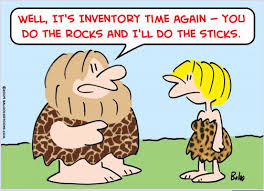My apologies to Andy Williams. No, not that time. You are now off and running in the great holiday race. Shelves are stocked, everything is decorated and business is booming. This is about about the next most wonderful time of the year: Physical Inventory. The key to a successful Physical Inventory (PI) is organization. I have some organizational steps that have proven successful in my past and continue help our customers today.
Start the old fashion way with pen paper and a calendar.
Timeline: Select the dates that you will be performing your physical inventory count. Make these dates known now so you are not besieged with vacation/time off requests for that week. Make it a blackout period when no one is off. It is very important to have the support of your staff in getting this task accomplished successfully. Taking into account your dates, set some guidelines for your purchasing and receiving areas. You should cut off merchandise delivery for a period of time prior to your PI (I used to cut off two weeks before my count date). A full PI is best scheduled during a period of time when your stock levels are at a low point, when there’s less to count and more room for organization of merchandise. If merchandise is received during this period set it aside and do not enter it into your system until after you have completed your counts.
Staffing: Ensure that you have allocated adequate staff for the task at hand. The physical count should be performed by teams of two, a caller and a recorder. The actual purpose of these individuals has changed from the days of pencil and paper tallies to having teams give credibility to the actual count in terms of checks and balances. It speeds the scanning process along as well (if you are using scanners) and as the count progresses, a second count can be completed. It is easier to verify the electronic count with teams of two and expedite recovery after the count is completed.
Maps: Draw a map of your store. I use graph paper but this can be done in excel or using various CAD (computer aided design) programs, which is a critical tool for successful preparation for a PI. You probably already have maps of your store(s) that are used for planning layouts, displays etc. Be sure to include all window displays, warehouses, storage closets, back office spaces, offsite storage and any place you can possibly have stored inventory. The idea of a having a map is to make sure you have gone through all of these locations thoroughly and that everything is counted. Check absolutely everywhere; in cabinets, under cabinets, on top of shelving units. I have found merchandise in old display units in storage, on top of and under warehouse shelving. It’s a good idea to check these odd locations where you have found merchandise after the PI has been completed; hidden merchandise is a Loss Prevention issue. Check desk drawers, closets and even the rest rooms. I used to check drop ceilings as well. I found a stack of denim in the ceiling once (I’m sure it was just misplaced!). Verify that each of these locations has been checked before your inventory begins, using your map for reference.
Fixtures: Label the map so each of your fixtures, every shelf, hang bar, t-stand and merchandise peg have a number and letter. A corresponding spreadsheet should be created listing each location and fixture; this spreadsheet and map will be used the day of your physical inventory to verify a physical count has been entered and verified by your team. I used to highlight the map to verify that an area has been counted and then check it off on the spreadsheet. Starting with yellow for first count, then blue, and green would mean that an area was finished. Count your fixture in numerical order not randomly; this is a time for order!
Tags: Nothing can hold up a physical inventory like merchandise without tags or with incorrect tags. It is important to have your staff verify that all merchandise has a bar code label prior to your count. Set up an area in your stock room for your team to place merchandise so it can be properly labeled before your PI and have it re-tagged. Faded or torn tags should be reprinted so that everything is counted properly. If you are scanning tags verify that your scanner can read your bar codes. I once attempted a PI and none of my tags scanned. I did not check prior to the team arriving and so I had to reschedule the PI. It was an expensive mistake I will never make again.
Pre-counts: Pre-counting merchandise can save you a lot of time. Have a plan for difficult to count items; counting bath beads by hand is not the most efficient way; use a scale. Chocolates, coffee, soaps and those small items at the POS should be pre-counted.
All of this is preparation for entering the counts into your software system and that process will differ based upon the software you’re running.
Remember this is not something that happens every day and it should be made into a special event. I always brought in food throughout the day and held a contest for the team member who found the most items with missing tags, etc. The point is that it is a time for cleaning up and getting on to the next page. Spring cleaning and setting order is actually happening after the holidays at the beginning of the New Year for most of you because you are setting the tone for the New Year. Embrace Physical Inventory! It’s a wonderful thing.
Happy Holidays!
Author Peter Pishko is VP of Operations at One Step Retail Solutions. One Step’s All About Retailing Blog tackles the topic of retail technology solutions and key retail trends.






